Martin P.M. Handbook of Deposition Technologies for Films and Coatings, Third Edition: Science, Applications and Technology
Подождите немного. Документ загружается.

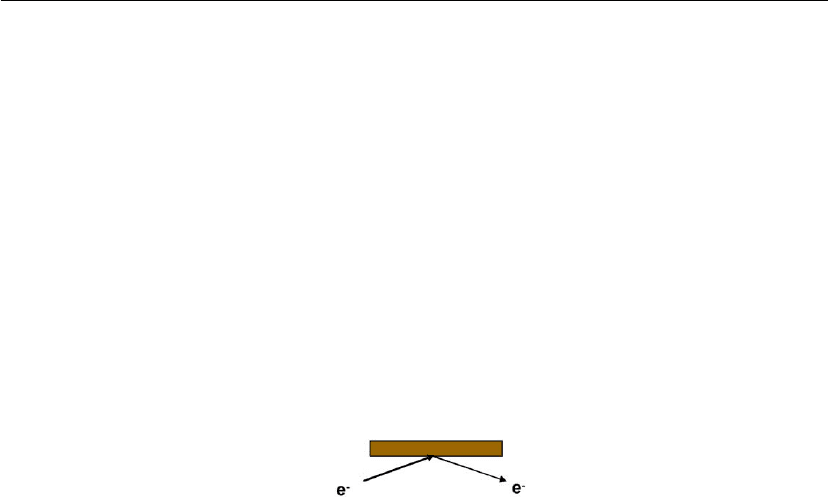
Characterization of Thin Films and Coatings 841
In order to obtain information about the actual atomic positions, intensity versus primary
electron energy curves (i.e. I–V curves) can be collected and diligently analyzed using
models of the surface structure along with the calculations involving multiple electron
scattering.
Despite the complicated nature of multiple scattering at low energies, the use of I–V curves
and theoretical modeling has continued to be useful for detailed analyses of surface structures
and is a major tool for examining surface reconstructions. Most real surfaces are not ‘ideal’
because many surfaces relax from bulk positions in order to reduce the surface energy. This
process is popularly known as reconstruction. Understanding surface reconstruction using
LEED can not only reveal the symmetry of the final structure but also provide information
regarding the interaction between the surface and overlayer [153].
16.5.4.2 Reflection High-Energy Electron Diffraction
In addition to surface crystal structure, RHEED can be effectively used to understand the
growth mode and deposition rate of films in situ. RHEED involves reflection of electrons
incident at grazing angles onto the film/substrate surface. When the films grow layer by layer
in a smooth fashion, the RHEED pattern appears as lines or streaks. On the other hand, if the
growth is associated with 3D structures typical diffraction spots appear, indicating a rough
surface. Therefore RHEED is useful to evaluate the quality of a growing film in situ (as shown
in Figure 16.66a–c). Chambers presents a detailed overview and explanation of various
RHEED patterns in a review article [154].
The semicircular zones of scattered beams in Figure 16.66(a–c) are a result of coherent
diffraction over length scales comparable to the electron coherence length (∼1000
˚
A for a
well-collimated beam). These scattered beams consist of spots for a crystalline surface. These
spots, as presented in Figure 16.66(a), are the diffracted beams within the zeroth order Laue
zone of Al
2
O
3
(0001). The spacing between two spots or two streaks is inversely proportional
to the in-plane lattice parameter perpendicular to the beam.
Under specific conditions, where the terrace widths are smaller than the electron coherence
length, the spots in a RHEED pattern become streaks. This leads to a spread in the electron
beam in the incident direction causing streaks to appear in the diffraction pattern. Further,
when the dimensions of the clusters growing on a substrate can result in predominantly
transmission of electrons (predominantly elastic scattering) rather than reflection, the
diffraction pattern appears as spots, as shown in Figure 16.66(c).
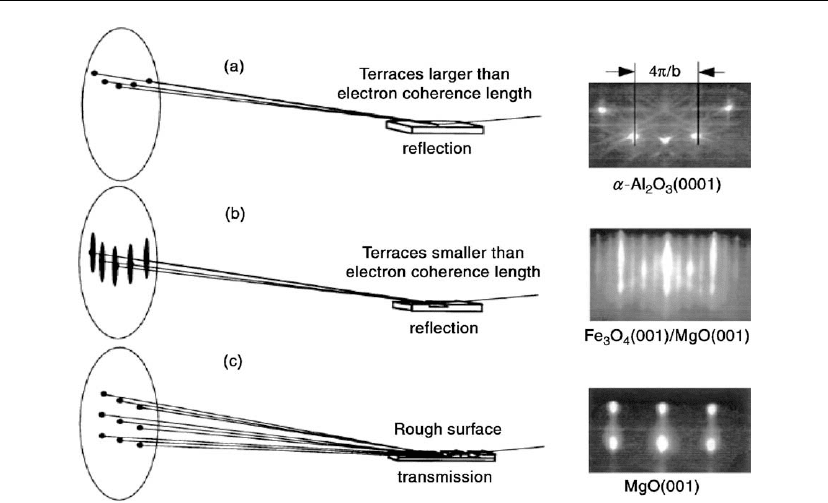
842 Chapter 16
Figure 16.66: Representative RHEED images along with possible surface characteristics. Evidently,
the RHEED pattern is dependent on the terrace widths on the film surface and the aspect ratio of
the film [154]. In the top right panel, the interplanar spacing in the film is denoted as b.
Typical RHEED patterns observed for epitaxial CeO
2
film on SrTiO
3
(100) substrate are
presented in Figure 16.67. These RHEED images are acquired during the deposition (in situ).
Kim et al. [152] used RHEED analysis along with photoelectron diffraction to explain the
growth of CeO
2
on SrTiO
3
(100). The effect of deposition temperature is evident from the
RHEED patterns. While the 550
◦
C substrate temperature leads to island growth, 650
◦
C and
750
◦
C lead to epitaxial layered growth.
Strengths:
LEED
Extremely surface sensitive.
Overlayer structural symmetry can be determined.
Surface reconstruction; impurity adsorptions can be identified.
RHEED
Suitable for in situ analysis.
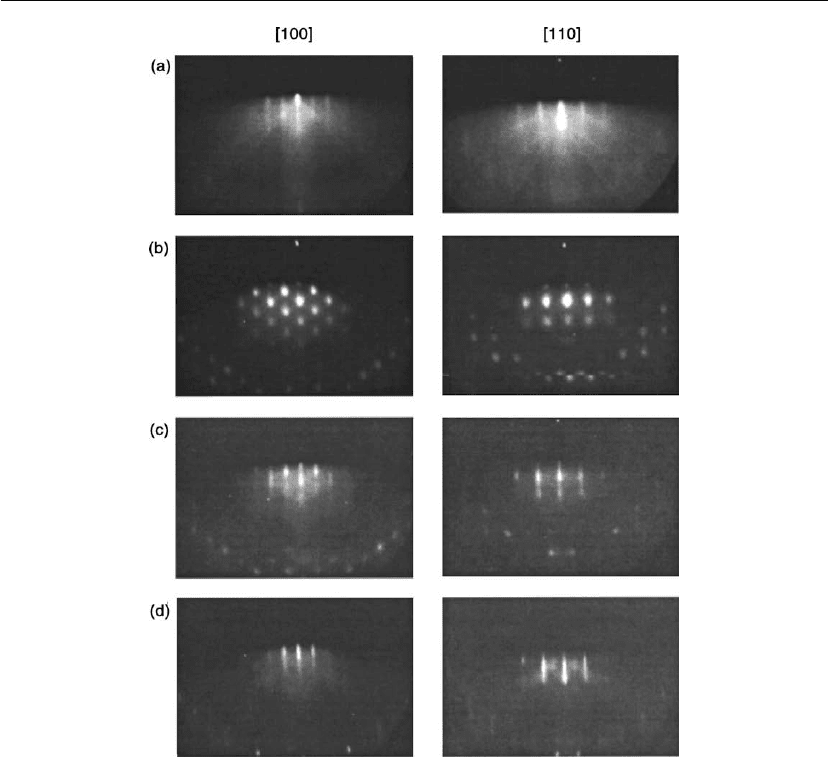
Characterization of Thin Films and Coatings 843
Figure 16.67: Typical RHEED (∼15 keV incident beam) patterns obtained during the growth of
CeO
2
film on (a) STO(001) substrate with the incident beam along (100) and (110) directions at
substrate temperatures, (b) 550
C, (c) 650
C, and (d) 700
C [152].
Excellent technique for monitoring epitaxial growth mode (island, layer, etc.).
Patterns are indicative of structural quality.
Limitations:
LEED
Backscattered geometry limits its use for in situ analysis.
Often, substrate diffraction pattern may also be present, thereby analysis becomes
complicated.
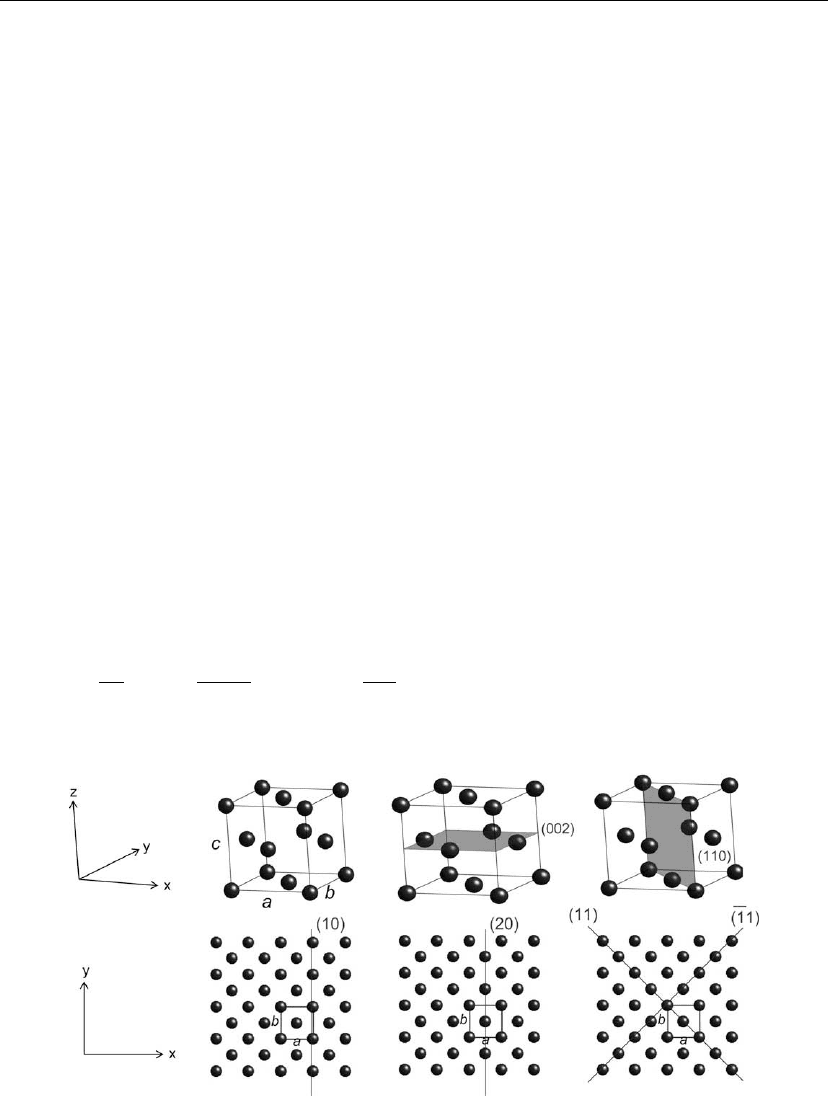
844 Chapter 16
RHEED
Fixed position of the RHEED optics restricts the geometry of deposition
instrumentation.
May not be suitable for high-pressure deposition chambers.
16.5.4.3 Reciprocal Lattice and Surface Crystallography
In 2D space the lattice can be conveniently defined with the help of lattice vectors a, b. The
comparison of 3D and 2D lattices and the corresponding Miller indices are presented in
Figure 16.68.
The reciprocal lattice in the 2D system can further be described as dealt as in the 3D case
explained later in this section. A detailed explanation of the relation between the surface and
substrate lattices and aspects of surface crystallography are explained in detail in various
dedicated surface science textbooks.
A fundamental understanding of electron and photon (e.g. X-ray) diffraction involves
considering the wave nature of electrons. In addition, it is beneficial to use the concept of a
reciprocal lattice. Since LEED deals with 2D surface structures the reciprocal lattice concepts
associated with 2D structures are briefly described here. Electrons have wave-like properties
which allow them to be scattered by a 2D array of atoms, providing the basis for ED. Despite
the oversimplified nature of the following discussion, it is helpful for understanding the
concepts important to ED [153].Ifk
0
is the incident electron wave vector, its amplitude can be
obtained by the deBroglie equation:
k
0
=
2π
λ
= 2 π
2meV
h
2
1/2
= 2 π
V
150
1/2
(16.8)
where V is in volts, λ is wavelength of the incident beam (
˚
A), and the unit for k
0
is (
˚
A)
−1
.
Figure 16.68: Miller indices description for (top) three dimensions, and (bottom) two dimensions.

Characterization of Thin Films and Coatings 845
The 2D arrays of atoms can be described with the help of two unit vectors a, b, similar to the
3D description with vectors a, b, c. As mentioned before, it is more convenient to use
reciprocal lattice notation to understand the interaction between the electrons (in wave form)
and the atomic rows. The reciprocal lattice coordinates can be deduced from the regular lattice
coordinates. If a*, b*, and c* are the lattice coordinates in the reciprocal space, then
a
∗
=
2πb×c
a(b×c)
b
∗
=
2πc×a
a(b×c)
c
∗
=
2πa×b
a(b×c)
(16.9)
This implies that the reciprocal lattice can be constructed by translation of reciprocal lattice
vectors, defined relative to the real-space vectors. Before going further, it will be useful to
understand the concept of the Ewald sphere. The important feature of this sphere is that when
the sphere cuts through the reciprocal lattice point the Bragg condition is satisfied and the
diffraction maximum occurs. Further, the criterion for constructive interference (diffraction
maximum) can only be observed when the change in the electron wave vector in the scattering
event equals a reciprocal lattice vector.
(k
− k
0
) = g = ha
∗
+ kb
∗
+ lc
∗
(16.10)
The Ewald sphere is an empirical construction [136] with a radius k
0
=2π/λ, with the vector k
0
extending from the center of the sphere terminating at a reciprocal lattice point. When the
reciprocal lattice point lies on the Ewald sphere, the condition (k
−k
0
)=g will be met. The
reciprocal lattice construction in the 2D case (e.g. a single atomic layer) involves allowing
lattice vector c to approach infinity, thereby resulting in c* →0. This makes the reciprocal
lattice appear like a series of rods in a 2D array rather than a 3D array of spots. This implies
that diffraction can be observed whenever a rod intersects the circle. Figure 16.69(a–c)
Figure 16.69: Ewald sphere construction for (a) the 3D case, (b) LEED configuration, (c) RHEED
configuration [154].
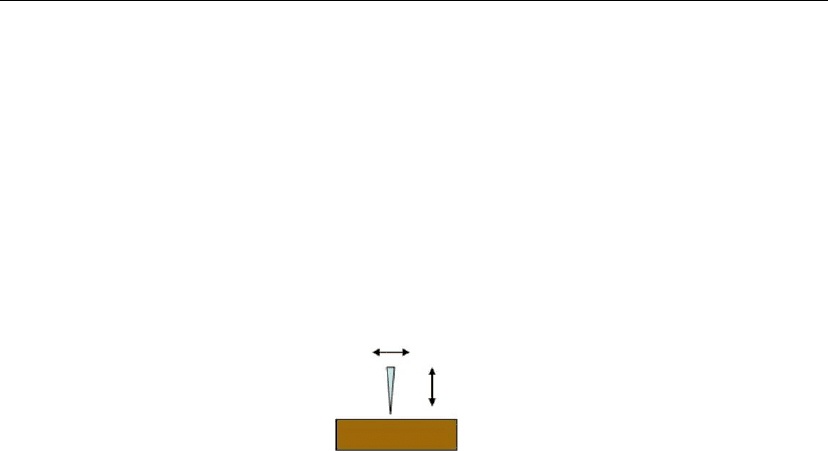
846 Chapter 16
depicts the Ewald sphere construction for the 3D case and for LEED and RHEED methods
[6, 154].
16.6 Other Methods
Additional methods described include scanning probe microscopy (SPM) (including STM and
AFM) and atom probe microscopy.
16.6.1 Scanning Probe Microscopy (STM, AFM)
A.S. Lea
SPM is a branch of microscopy that has developed in a variety of useful ways to provide
nanometer-resolution information about many properties of a sample, including topography,
hardness, and conductivity. Images that are formed arise from the interaction of a proximal
probe with a surface. The image is formed as the probe is scanned mechanically across the
surface in a raster pattern while keeping track of the probe sample interaction as a function of
tip position. Depending on the type of probe that is utilized, different scanning probe methods
can be invoked. The two that are most commonly use in the analysis of surfaces and thin films
are STM and AFM. AFM is often called scanning force microscopy (SFM) to be consistent
with the nomenclature of the other types of scanning probe microscopies. While these two
techniques will be highlighted in this section, it is pointed out that there are over 20 different
SPM techniques in existence today. The spatial resolution of these techniques varies
depending on the type of interaction utilized, but in some cases atomic resolution is
achievable.
The origin of the scanning probe microscope came with the invention of the STM by Binnig
and Rohrer in 1981 [155]. Though the electron tunneling process had been known since the
1950s, the ability to control the tunnel gap and scan an electrode across the surface facilitated
the invention of the STM. This was largely due to the development of piezoelectric actuators
that control motions in a highly precise and accurate manner. It could be argued that the
invention of the STM led to the development of the field of nanotechnology, not to mention the
other scanning probe techniques, and for this effort Binning and Rohrer were awarded the
Nobel Prize in Physics in 1986, a mere five years after its invention.
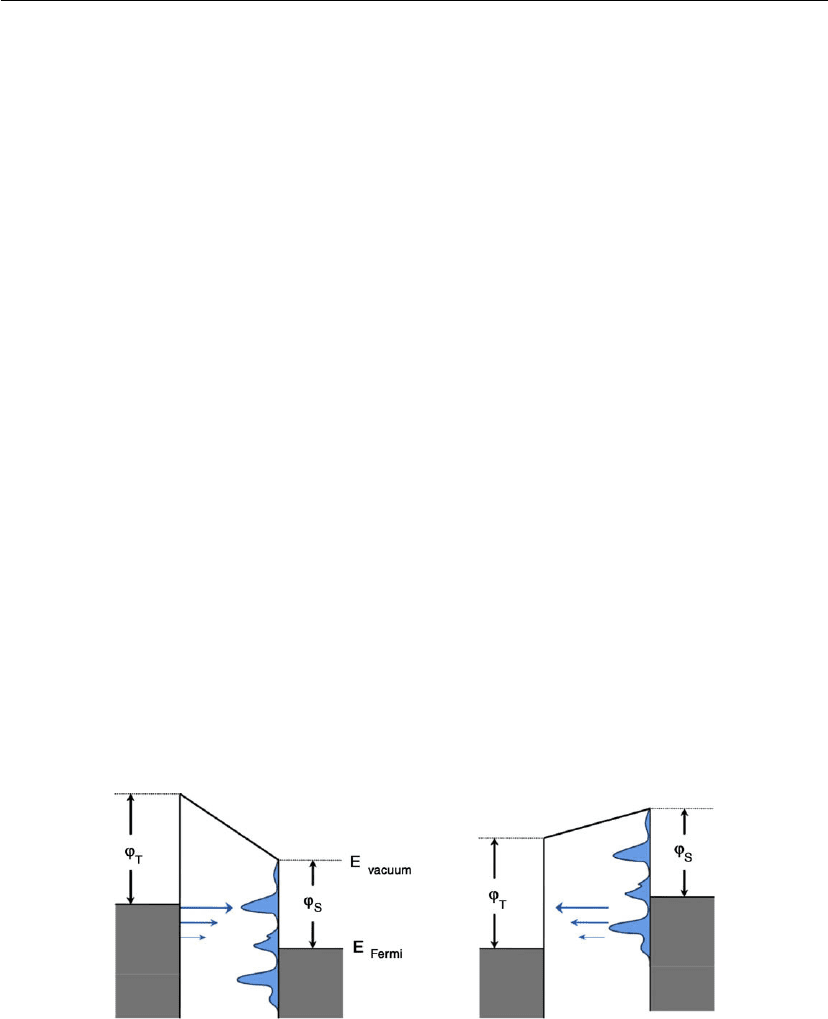
Characterization of Thin Films and Coatings 847
16.6.1.1 Scanning Tunneling Microscopy
STM is a powerful technique that enables the imaging of conductive surfaces down to the
atomic level. This technique is based on the quantum tunneling of electrons between two
surfaces as they are brought sufficiently close together that their electron clouds begin to
overlap. In STM, the tip of an atomically sharp electrode is positioned within a few
nanometers of the surface and at low tip voltage bias probes the density of electronic states of
the atoms comprising the surface by monitoring the tunneling current. Figure 16.70 depicts the
tunneling processes for two surfaces that are within close proximity such that their electron
clouds overlap. In the case of a negative tip bias, current is measured through tunneling of
electrons from the occupied states in the tip into the unoccupied states in the sample [156].For
a positive tip bias, electrons tunnel from occupied states in the sample into unoccupied states
in the tip. Depending on the applied bias voltage, one can therefore image either the occupied
or unoccupied states in a sample. Figure 16.71(a) depicts the imaging of the occupied
electronic states of the silicon carbide sample using a positive tip bias, and Figure 16.71(b) the
unoccupied states of the SiC(0001) when a negative tip bias is utilized [157].
It is evident from Figure 16.71 that in some cases atomic resolution is achievable using STM.
The basis of this high resolution is the distance dependence of the tunneling current. The basic
equation for the tunneling current (or transmission probability) is:
Iαe
−2κz
(16.11)
where z is the separation distance between the tip and sample, and parameter is defined by
κ
2
= 2 m(V
B
− E)/¯h
2
. Here, m is the mass of an electron, V
B
is the potential in the barrier, E is
the energy of the electronic state, and ¯h is Planck’s constant [156]. In the simplest case, V
B
is
the vacuum level, so for states at the Fermi level, (V
B
−E) is just the work function (φ). The
Figure 16.70: Energy level diagram of the tip and sample during STM in two different bias
conditions: (a) with a negative tip potential in which electrons tunnel from the tip into unoccupied
states in the sample, and (b) a positive tip in which electrons tunnel from occupied states in the
sample into the tip.

848 Chapter 16
Figure 16.71: Imaging of a SiC(0001) 3 ×3 surface using (a) a positive tip potential in which the
occupied states of the sample are shown and (b) a negative tip potential in which the unoccupied
states of the sample are shown [157].
values of most work functions are around ∼4–5 eV, meaning that κ is approximately 1
˚
A
−1
.
Using this value for κ in Eq. (16.11), one can see that the tunneling current drops by an order
of magnitude for every
˚
Angstrom of separation. It is not hard to see that most of the interaction
between the tip and the sample comes from a single atomic asperity at the end of the STM tip,
which enables one to measure tunneling currents on a sub-
˚
Angstrom level and produce atomic
scale images. The optimum spatial resolution for an STM is approximately < 0.1
˚
A vertically
and < 1
˚
A laterally, but this depends on the tip sharpness, surface roughness, electronic noise,
and level of vibration in the system.
The strong dependence of the tunneling current on the separation distance demands the ability
to precisely control the tunneling junction. This precision is achieved through the use of
piezoelectric actuators that can control movement of the STM tip in three dimensions on a
sub-
˚
Angstrom scale. A typical schematic of an STM instrument is depicted in Figure 16.72.
The piezoelectric actuators are monoliths typically made from lead–zirconium–titanates
(PZTs) and have a sensitivity on the order of 1–5
˚
A/V [158].
In order to maintain this precise level of control it is necessary to isolate the instrument from
external vibrations, limiting these to magnitudes much less than 1
˚
A using vibration isolation
equipment [159]. The principle behind the operation of an STM is quite simple. While a
voltage bias is applied across the tunnel barrier, the tunneling current is measured and kept
constant through computer-controlled feedback which controls the separation distance using
the vertical piezoelectric actuator, as the tip is rastered across the sample surface using the
horizontal actuators. This is the ‘constant current’ operation mode in which the sample
topography is reflected through the path of the tip. Another, though less practical, mode is the

Characterization of Thin Films and Coatings 849
Figure 16.72: Simplified schematic of a typical STM instrument.
‘constant height’ mode, where the tip is maintained at a fixed height above the average surface
and the topography is reflected in the variations in tunneling current. The constant current
mode is in many cases the most practical imaging mode and is used to obtain topographic
images of surfaces, down to the atomic scale in some cases.
Strictly speaking, STM measures not sample topography, but the local density of states of the
sample. In the simplest case of an elemental sample, the local density of states is uniform and
the variation in tunneling current is indeed directly related to topography. For multicomponent
samples, this is not the case, as different atoms have different densities of electronic states. An
excellent example of this is depicted in Figure 16.73, which shows a quantum corral
comprised of Fe atoms arranged in a circular pattern on a Cu (111) [160] substrate. While
there are no atoms on the surface lying in the corral, local maxima and minima, corresponding
Figure 16.73: STM image of Fe atoms on Cu(111). Inside the quantum corral the STM measures
the variations in local density of states due to electron standing waves [160].

850 Chapter 16
to the standing electron waves generated by this construction, are visible. Adsorbates on a
sample surface, which have different electronic density of states from that of a uniform
substrate, and which alter the surface topography of the sample, will change the tunneling
current passing through the tip as it passes over it. This provides contrast in an STM image,
allowing this technique to probe the shape, conformation, and distribution of atoms or
molecules residing on the surface of an atomically flat conducting substrate.
Scanning tunneling spectroscopy [161] is another valuable imaging mode, whereby the
tunneling current is measured as a high-frequency voltage modulator is added to the tip bias.
The usefulness of this method becomes apparent through the Wentzel–Kramers–Brillouin
(WKB) approximation of the tunneling current shown in Eq. (16.12):
I =
ρ
t
(E) ρ
s
(eV + E) T (E, eV )dE (16.12)
where ρ
t
(E) is the density of electronic states in the tip at energy E, ρ
s
(eV + E) is the density of
electronic states in the biased sample, and T(E, eV) is the tunneling transmission probability.
Assuming that the density of states in the tip is constant, then a measure of dI/dV produces a
signal that is directly proportional to the local density of states in the sample. Another useful
tunneling spectroscopy mode involves measuring the tunneling current as the tip height is
modulated slightly above the surface [161]. In this mode, it is possible to obtain d(ln I)/dz
which is directly proportional to the local work function (see Eq. 16.11) across the entire
surface.
One of the strengths of STM is its ability to operate in different controlled environments,
allowing it to be broadly applicable to many scientific disciplines. The STM can operate under
vacuum, in ambient conditions, in aqueous (condensed phase) systems, and at hyperthermal or
cryogenic temperatures. This versatility enables the instrument to collect data in kinetic
systems in real time, allowing the researcher to collect dynamic information about the systems
being investigated. This has become particularly useful in the investigation of fundamental
chemical reactions that occur on model surfaces under controlled environments, enabling
researchers to study the reaction pathways in catalytic systems. STM has been an invaluable
tool in such diverse fields as materials synthesis and characterization, catalysis,
microelectronics, electrochemistry, and biology.
A few limitations of the technique are mentioned here. First and foremost, since the interaction
of the probe and sample involves tunneling current, it is necessary that the sample is
sufficiently conducting to allow current to flow between the tip and sample. Insulating
specimens are therefore very difficult to analyze using STM. Second, the precise control of the
tunnel gap needed in a STM precludes the study of extremely rough samples. Roughness on
the order of a few micrometers is generally considered too rough to make imaging practical.
Third, one needs to be wary of possible tip-induced image artifacts due to poorly shaped tips,
allowing for multiple tip–surface interactions.
